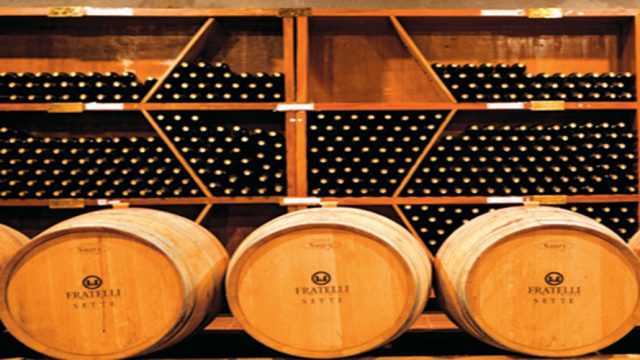The first mention of wine in the Indian context can be traced back to 1500–500 BCE. The Indo-Aryans indulged in intoxicating drinks, and the Vedas, too, speak of an alcoholic beverage, called Sura, a rice wine fermented with honey. Interestingly, it was Chanakya who made the first mention of grape-based wines in his writings: in his chronicles of the Emperor Chandragupta Maurya’s court, Chanakya condemns the frequent consumption of a grape wine called madhu.
Centuries later, the Kshatriyas (a social order of the Hindu society) claimed wine to be their preferred drink while the lower classes would usually drink alcohol made from wheat, barley and millet. Under the Mughal rule, however, alcohol was completely banned due to religious restrictions.
Portuguese colonists arrived in the 16th century and introduced Port to India, while the British rulers also encouraged winemaking to cater to their own needs. And soon, vineyards were developed in Baramati (Maharashtra), Kashmir and Surat.
The state of Maharashtra has been dubbed the wine capital of India. With a favourable climate and relatively simple government regulations, wine producers are flocking to Maharashtra and setting up wineries. These factors have also made it one of the largest wine producing regions in the country. Vineyards in the state are found in the Deccan Plateau region and around Baramati, Nashik, Pune, Solapur and Sangli. Some of the more well-known wineries in the state are Sula, Fratelli Wines, York Winery, Chateau d’Ori, Grover Zampa and Vallonne. Nashik, in particular, with its warm days and cool nights provides an ideal setting for the cultivation of grapes. This sort of climate ensures the grapes retain their acidity and develop a distinct flavour.
Wine tourism is becoming increasingly popular as is evident by the growing number of wineries that organize tasting sessions and festivals with a focus on the spirit. Gorgeous locales, luxurious retreats and a unique holiday experience, all attract draw people to wineries. The famed Sula Vineyards, hosts an annual festival called Sulafest in February, which features music performances. Grover Zampa vineyards organizes The Great Grover Stomp, and as is apparent from the name, this festival encourages attendees to stomp grapes for fun.
Drinking an occasional glass of wine is known to have health benefits such as a decreased risk of a heart disease, stroke and diabetes. Indians are apparently paying attention, since the wine consumption in the country is escalating. In fact, according to a survey by a leading media house, by the year 2017 wine consumption in India will have risen to 2.1 million cases – a steady 73% increase since 2013.

Types of Wines
Listed here some of the more popular wine varieties. In the context of wine, the word variety is used to describe the type of grape – so many wines are named after the grape that is used to create them.
Types of white wine grapes
RIESLING (Rees-ling)
Districts: the classic German grape of the Rhine and Mosel, riesling grows in all wine districts. Germany’s great Rieslings are usually slightly sweet, with steely acidity for balance. Riesling from Alsace and the Eastern USA is also excellent, equally aromatic but typically drier (not sweet). California Rieslings are usually sweet and lacking in acidity for balance.
CHARDONNAY (Shar-doe-nay)
Districts: Chardonnay makes the principle white wine of Burgundy (France). The grape is successfully grown in most viticultural areas under a variety of climatic conditions.

SAUVIGNON BLANC (So-vee-nyon Blah) Districts: New Zealand produces excellent Sauvignon Blancs. Some Australian Sauvignon Blancs, grown in warmer areas, tend to be flat and lack fruit qualities. In France, Sauvignon Blanc is grown in the Bordeaux district. It is also grown extensively in the upper Loire valley where it is made as a varietal wine.
Types of red wine grapes
SYRAH(Sah-ra or Shi-raz)
Shiraz or syrah are two names for the same variety. Europe vine growers and winemakers only use the name syrah.
Districts: syrah excels in France’s Rhône Valley, California and Australia.
MERLOT(Mer-lo)
Easy to drink. Merlot’s softness has made it an “introducing” wine for most new red-wine drinkers.
Districts: a key player in the Bordeaux blend, merlot is now also grown on the US West Coast, Australia and other countries.
CABERNET SAUVIGNON
(Ka-ber-nay So-vee-nyon)
Cabernet sauvignon is often blended with cabernet franc and merlot. It usually undergoes oak treatment.
Districts: cabernet sauvignon is planted wherever red wine grapes grow except in the northern fringes. It is part of the great red Médoc wines of France, and among the finest reds in Australia, California and Chile.
PINOT NOIR (Pee-no Nwar)
One of the noblest red wine grapes — difficult to grow, rarely blended, with no roughness.
Districts: makes the great reds of Burgundy in France, and good wines from Austria, California, Oregon, and New Zealand.
Source: www.frenchscout.com




